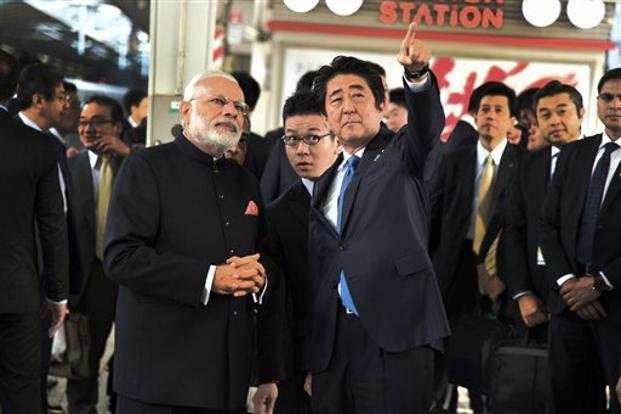Ahmedabad: India’s creaking, colonial-era railway system is preparing to take a giant leap forward as the Indian prime minister breaks ground on the country’s first bullet train project.
Narendra Modi laid the foundation stone for the high-speed line on Thursday during a visit by his Japanese counterpart, Shinzō Abe, to the western state of Gujarat.
“This is the new India and the flight of its dreams is endless,” Modi said at the ceremony. “The bullet train project will bring speed and employment. It is human-friendly and eco-friendly.”
The high-speed line, which the government aims to launch by the 75th anniversary of Indian independence on 15 August 2022, will run from Ahmedabad, the Gujarat capital, to the financial hub of Mumbai.

Indian officials say the train will have a maximum speed of 217mph (350km/h), more than twice the speed of the country’s current fastest train, which runs from the capital, Delhi, to Agra at a comparably sluggish maximum of 100mph.
The Shinkansen model train will cut the 316-mile journey from Ahmedabad to Mumbai from eight hours to around three.
More than four-fifths of the project’s $19bn (£14.4bn) cost will be funded by a 0.1% interest-rate loan from Japan as part of a deepening economic relationship that both countries hope will act as a bulwark against Chinese influence in Asia. “Japan has shown that its a true friend of India,” Modi said on Thursday.
The fast rail is also significant for the Modi government, which made the bullet train a key part of the modernisation agenda on which it campaigned at the 2014 elections. It also claims the project will create about 36,000 jobs.

India is reportedly considering another six potential high-speed rail corridors, including one connecting Mumbai and Delhi. But the former chairman of India’s railway board Vivek Sahai said that the financial investment required to build such fast rail meant it was unlikely to phase out traditional trains any time soon.
“India runs more than 10,000 trains each day, which carry the equivalent of the population of Australia – you can’t just discontinue them,” Sahai said.
The country might also find it cheaper to invest in medium-speed trains that could run on the existing system, he added, rather than paying for the special infrastructure required to run bullet trains.
The spread of super-fast trains would ultimately “depend on the finances”, he said. “High speed trains have to come to India … but how to get it and the financial viability of the projects is still to be questioned,” he said.
Trains are still the preferred choice of long-distance travel for most Indians but passenger numbers, particularly in the more expensive berths, have started to decline since 2014.
Growing incomes in the past three decades have seen a surge in car ownership, and India’s domestic flight market grew 14% last year, second only to China’s.
The industry is also marred by a horrendous safety record: a 2012 government report referred to the annual death toll from the country railway’s system as a “massacre”.
More than 33,700 people died in train-related accidents in 2015, the most recent year for which data is available, the majority by falling from overcrowded trains or being hit as they tried to cross tracks.
buy nolvadex generic noprescriptionrxbuyonline.com/nolvadex.html over the counter
Modi replaced the country’s railway minister in August after a horror 12 months that included an accident last November that killed 150 people.
The government has committed to spending $137bn (£111bn) over its five-year term to upgrade India’s railways, including improving track structure and introducing long welded rails and track patrols to prevent railway infrastructure from falling into disrepair.
India’s train network, built during British colonial rule is Asia’s oldest and the fourth-longest in the world, covering more than 67,000km.



